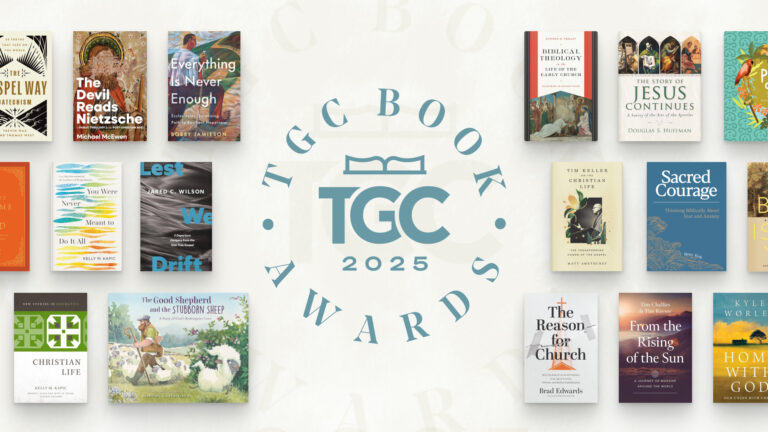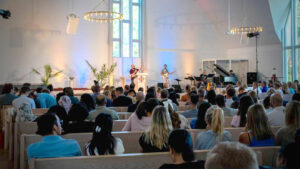What might medieval Catholic poet Dante Alighieri teach Protestants today? A lot, actually.
Dante’s masterpiece, The Divine Comedy, has been rightly called “one of the essential books of mankind.” Hundreds of extant early manuscripts and printed editions attest to the popularity of the work in its own age. Its treatment by the world’s great artists, musicians, and writers over the past 700 years proves its continued lure. It has been translated into English countless times and featured regularly on lists of the world’s best books and best poetry. Earlier this year—the 750th anniversary of Dante’s birth—Rod Dreher published a marvelous book How Dante Can Save Your Life [review], meditating on the power of the poem to change his life.
While The Divine Comedy most clearly reflects the Catholic faith of the poet and his medieval world, it hints at some principles the Reformation would bring to bear on the church two centuries later. Dante purposely wrote in a low style that would have popular appeal despite its highly spiritual subject matter. While the church produced works in Latin, Dante wrote in the vernacular. His choice was revolutionary, ensuring the work could and would be read by common men as well as by women and children (who still study the work extensively in Italian schools today).
Despite its loftiness, The Divine Comedy is firmly grounded in the gritty and the mundane. In fact, Dante didn’t use the word divine in his title. He simply titled it Commedia, which at the time meant a work with a happy ending as opposed to a tragic one. (The word “divine” was added by a later editor and has stuck through the years.) In casting a fictional version of himself as the central figure, The Divine Comedy is prophetically personal, confessional, and autobiographical. In this way it emphasizes a surprisingly modern sense of self-determination, one that foreshadows the famous “Protestant work ethic.” Moreover, in its accent on the salvation and purification of the individual soul, this work of the Catholic Dante anticipates the spiritual autobiographies of Puritans such as John Bunyan. The Divine Comedy is a story of someone seeking salvation. In Dante’s own words, the poem’s purpose is to lead readers from “a state of wretchedness to a state of happiness.” And while depicting salvation in the afterlife, it’s clear Dante intends readers to find abundant life in the here and now.
Spiraling Poetic Path
The metaphor of the journey for the spiritual life transcends the Catholic-Protestant divide. Dante’s famous poetic innovation, terza rima—three line stanzas linked to one another by interlocking rhymes (aba, bcb, cdc, and so on)—leads the reader step by step, impelling us forward from one stanza to the next. And while the poem is intricate and exhaustive, its clear tripartite organization into 100 cantos divided evenly among three sections (and one introductory canto) provides a spiraling but certain path. One may not know what lies ahead, but the path is clearly laid out, something like a more complex, ornate version of the Romans Road.
Indeed, like the Romans Road, the Divine Comedy opens with the recognition of powerlessness, as the pilgrim Dante is lost in the woods as darkness falls. He encounters three beasts, symbols of the temptations to sensuality, pride, and avarice. Then the Roman poet Virgil appears, promising to lead the wayward soul to heaven—but to get there they must go through hell. This part of the poem, Inferno, has captured readers’ attention over the centuries. It is simply a fact of both human nature and art that, to artist and audience alike, fallenness proves more fetching than holiness.
In Dante’s vision of hell, eternal torment is one’s own doing; sin becomes its own punishment. For example, the lustful are tossed by gusts of wind forevermore, the wrathful are trapped in eternal fighting, the flatterers are mired in human excrement, and the sorcerers who claimed to see the future face eternity with their heads on backwards. Dante’s famous nine circles of hell place the milder sins on the outer circle with the sins growing graver as the circles spiral downward. Dante’s ranking of sins offers insights to us today since we, too, tend to rank sins more often according to a cultural rather than a biblical rubric. Dante portrays heresy as less serious than sodomy, which is one of the violent sins, placed in the seventh circle after suicide but just before usury. The lustful and gluttonous (the incontinent) are in the outer circles, while seducers, flatterers, and hypocrites (the fraudulent) are in the eighth circle. The ninth circle is home for those guilty of the sins of betrayal: of family, country, guests, and finally benefactors. It is here that Judas is found—just before Satan.
Surprisingly, Dante envisions the pit of hell as filled, not with fire and brimstone, but ice. There a monstrous Satan is trapped up to his chest, flapping his bat-like wings for eternity. Dante poetically depicts hell as a place of atrophy and stagnation, where movement, growth, and change—which are always available in life—are no longer possible. Once unrepentant sinners leave life, they are frozen for eternity in their sins. But, the poem suggests, sin freezes us in this life, too.
Purifying Fire
After descending all the way to the center of the earth where hell is housed, Dante proceeds out of it simply by stepping forward. He emerges on the island of Mount Purgatory and begins an ascent that will eventually take him to heaven. While purgatory is clearly rooted in Roman Catholic doctrine, Dante depicts it as the kind of purgation of sins that slightly resembles the Protestant understanding of sanctification. In Purgatorio, the pilgrim encounters repentant sinners in the process of shedding their defects of character and shortcomings so as to achieve a purified state befitting heaven. The circles of hell are paralleled by seven terraces leading upward. Sins are arranged in the reverse order of hell, with the graver sins of the will encountered first followed by those of the flesh: pride, envy, wrath, sloth, avarice, gluttony, lust.
Virgil, Dante’s guide, explains that all actions stem from either natural or spiritual love. Perversion of love leads to the sins from which one must be cleansed. Here, he echoes Augustine on sin as disordered love, a theme recently revived by Tim Keller. Upon reaching the last level of purgatory, Virgil declares: “Your will is free.” The greatest revelation of Dante’s journey comes when he realizes that all shortcomings are shortcomings of love.
Allegory’s End
Rich in classical myth, Roman Catholic theology, and historical allusions, the allegory of The Divine Comedy is neither straightforward nor always doctrinally correct. Christ’s presence in the poem—most pointed in the poet’s direct encounter with the mystery of the incarnation—is symbolic, not unmediated. Dante’s journey only somewhat resembles the Romans Road. Even so, the poet credits God’s grace, proclaiming in the last canto that it was
grace abounding that had made me fit
to fix my eyes on the eternal light
until my vision was consumed in it.
The phrase “grace abounding” is part of the title of the famous spiritual autobiography of John Bunyan who, centuries after Dante, would write the world’s best-known allegory, Pilgrim’s Progress. Allegory is a literary form that imitates the layers of our physical and spiritual existence as human beings. Pilgrim’s Progress is the perfect Protestant allegory, in both form and content.
But all allegory provides practice for reading life in a way that sees spiritual truth in material reality, similar to the parables of Christ. This is the sort of deep practice that reading The Divine Comedy provides and the benefit Protestants can gain from traveling with Dante on his symbolic journey.
Download your free Christmas playlist by TGC editor Brett McCracken!
 It’s that time of year, when the world falls in love—with Christmas music! If you’re ready to immerse yourself in the sounds of the season, we’ve got a brand-new playlist for you. The Gospel Coalition’s free 2025 Christmas playlist is full of joyful, festive, and nostalgic songs to help you celebrate the sweetness of this sacred season.
It’s that time of year, when the world falls in love—with Christmas music! If you’re ready to immerse yourself in the sounds of the season, we’ve got a brand-new playlist for you. The Gospel Coalition’s free 2025 Christmas playlist is full of joyful, festive, and nostalgic songs to help you celebrate the sweetness of this sacred season.
The 75 songs on this playlist are all recordings from at least 20 years ago—most of them from further back in the 1950s and 1960s. Each song has been thoughtfully selected by TGC Arts & Culture Editor Brett McCracken to cultivate a fun but meaningful mix of vintage Christmas vibes.
To start listening to this free resource, simply click below to receive your link to the private playlist on Spotify or Apple Music.


































